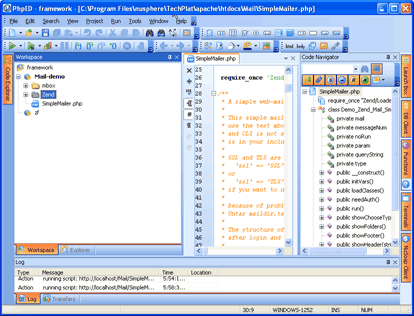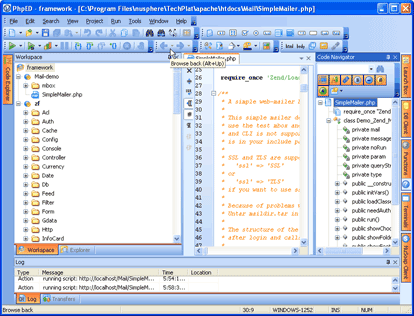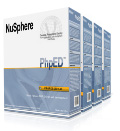Zend Framework Development
|
Zend Framework Tutorial Format
If you read our other tutorials on PHP Frameworks you noticed that most of them are written in classic manual’s format. We decided to make a change for Zend Framework tutorial and use the format similar to the one used for description of our PHP Tools. After all Zend Framework is one of many MVC Frameworks designed to be a PHP Development KIT, so everything we said in CakePHP for example, equally applies to Zend Framework. In this tutorial we will concentrate mostly on answering questions about Zend Framework asked on NuSphere PHP IDE Forum.
In addition to this material we hope you will check out tons of the information available elsewhere on http://www.nusphere.com, especially in PHP Frameworks. Specifically:
- Tips and tricks on how to start MySQL and Apache from PhpED can be found in Joomla tutorial (among great many other things)
- PHP Debugging, remote and local, using Ajax or not described in multiple documents:
Now, let’s talk about the specifics of Zend Framework used in development with PhpED.
Requirements for this tutorial
There is a couple of things we will assume:
- We will be using one of Zend Framework demo applications SimpleMailer.php. For this purpose we created Mail-demo project in PhpED and will be referring to it in this tutorial. You will also need to create a project in PhpED to build your Zend Framework Application.
- Zend Framework can be downloaded from http://framework.zend.com/ . It is FREE and available – all 1500 files with 100+ PHP classes. Zend tends to think big. Just extract it in the directory of your choice. As far as working with PhpED is concerned you have many choices, but the most common are:
- Option #1. Place Zend Framework in the same project with your Application, for example like it is shown below:

- The advantage of this method is quite obvious: Debugging and Code Insight don’t require any additional setup – everything will just work.
- The drawback however is also there: it makes sharing of Zend Framework libraries between the projects very difficult. It also most likely places Zend Framework under Document Root where it can be served by the web server.
- Option #2. In another common setup Zend Framework files are placed in their own project. This is typical scenario and it works like a charm in PhpED after a couple of settings are done as described further in this manual:

- Apache Web Server. We will be using Apache distributed with NuSphere Technology Platform - our fre integrated bundle of the most recent versions of Apache web server, PHP, along with other necessary development and administrating tools. However, everything we will be doing is very generic and independent of the way Apache is installed. You can follow the steps outlined in this tutorial if you are using any other installation of Apache, for example XAMP – which is used in NuSphere’s Joomla Development tutorial.
- PhpED – NuSphere’s PHP IDE. If you don’t have PhpED yet you can download a free trial of our famous PHP IDE here.
|
Article continues:
<<previous page
next page>>
|
|
 Download NuSphere PHP IDE Download NuSphere PHP IDE
Download a free trial of the fast PHP EDitor and robust Integrated Development Environment for PHP.
|
 Buy NuSphere PhpED® now Buy NuSphere PhpED® now
|
 Special Team4 Offer Special Team4 Offer
Get 4 copies of PhpED for the price of 3!
Optimum solution for development teams.
|

|
|
Need more than 4 licenses? Contact Us for more quantity discounts, please use "Ordering/Payment issue" subject on the form.
|
|
"To be honest its bloody awesome, I have looked at loads of PHP editors and this is THE only one that actual works straight out of the box!!! Brilliant, well done."
Andrew Breward,
Director of Technology
caboodal.com
|
|